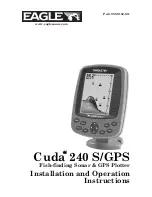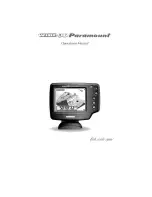
Glossary
Sonar Terms
126
and structure. Many Humminbird® units operate at up to 40 times per second when
in single frequency operation. Due to the limitation of the speed of sound in water,
the update rate begins to slow as depth increases to deeper than 50 feet. In very
shallow water (less than 10 feet), however, update rates as much as 60 times per
second can be achieved.
Speed:
Speed is the rate at which the boat moves through the water. Boat speed
can be measured as Speed Over Ground or Speed Through Water. Speed Over
Ground is provided by GPS, and is the measurement of the boats progress across
a given distance. Speed Through Water is provided by a speed paddlewheel, and
is the measurement of the flow past the boat, which may vary depending on
current speed and direction. Speed Through Water is most critical for anglers
using downriggers, as it impacts the running depth of the down riggers. Speed
Over Ground is optimal for navigation, as accurate destination times can be
derived from this measurement. Humminbird® products allow for input and
display of both sources.
Structure:
Structure is a general term for objects on the bottom that present a
discontinuity and are a likely attractor for fish. This includes bottom contour features
(drop-offs, humps, and holes), standing structure (stumps, timbers, brush piles) and
a wide range of other potential objects (sunken boats, reefs). Humminbird® units
excel at showing structure with great detail over a wider area due to unique sonar
configurations developed for the angler.
Structure ID®:
Structure ID® is a Humminbird® feature that describes the traditional
grayscale method of presenting sonar information. See
Grayscale
.
Surface Clutter:
Surface Clutter is a phenomenon where sonar returns are
reflected off of tiny objects near the surface of the water, including algae and even
air bubbles. Typically, saltwater environments have significantly greater surface
clutter than freshwater due to continuous wind and wave action that causes
aeration at the surface. The Surface Clutter menu provides manual control to bias
the default settings under extreme conditions.
Target Separation:
Target Separation is the measurement of minimum distance
that a fishfinder needs to be able to recognize two very close objects as two distinct
targets (i.e. two fish hanging very close, or a fish hanging very close to structure).
Humminbird® fishfinders provide a very good 2 1/2 inches of target separation in
shallower than 100 feet of depth. Target separation decreases as depth increases
due to the need for longer Pulse Width to achieve greater depth. See
Pulse Width
.
Thermoclines:
Thermoclines are water layer(s) of distinctly different temperatures
that create a sonar reflection due to the density of the differing water temperatures.
Typically a thermocline will appear as a continuous band across the display at some
distance above the bottom contour. Thermoclines are of interest to anglers because
fish will suspend above or below the thermocline as they seek the optimum
temperature and oxygen levels.
Time Variable Gain:
Time Variable Gain is a processing step applied to the sonar
return to "normalize" the data so that objects of equal size (i.e. fish) appear to be
the same size, even if they are separated by a good distance. Time Variable Gain is
a fundamental attribute of good sonar, but is often promoted as a feature.
Total Screen Update®:
A Humminbird® feature that refreshes and updates all
the sonar information on the display when a range change occurs. Without Total
Screen Update®, only the most recent sonar information would be drawn to the
new range, and the old sonar information would continue to scroll off the screen
at the old range.


























